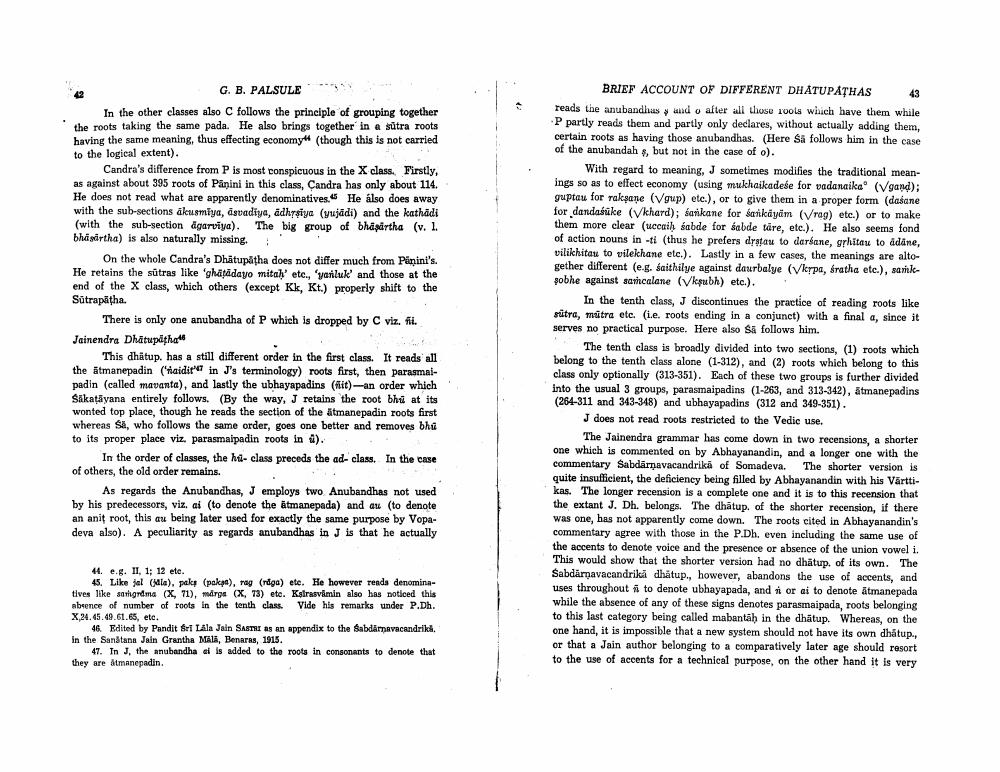Book Title: Brief Account Of Different Dhatupatras Author(s): G B Palsule Publisher: G B Palsule View full book textPage 4
________________ G. B. PALSULE In the other classes also C follows the principle of grouping together the roots taking the same pada. He also brings together in a sūtra roots having the same meaning, thus effecting economy (though this is not carried to the logical extent). Candra's difference from P is most conspicuous in the X class. Firstly, as against about 395 roots of Panini in this class, Candra has only about 114. He does not read what are apparently denominatives. He also does away with the sub-sections ákusmiya, svadiya, adhrsiya (jadi) and the kathddi (with the sub-section agarviya). The big group of bhartha (v. 1. bhairtha) is also naturally missing. On the whole Candra's Dhātupatha does not differ much from Pinini's. He retains the sutras like 'ghatādayo mita' etc., 'yarluk' and those at the end of the X class, which others (except Kk, Kt.) properly shift to the Sutrapatha. There is only one anubandha of P which is dropped by C viz. fil. Jainendra Dhätupitha This dhatup, has a still different order in the first class. It reads all the atmanepadin ('haidir in J's terminology) roots first, then parasmalpadin (called mavanta), and lastly the ubhayapadins (filt)--an order which Sakatāyana entirely follows.(By the way, J retains the root bhi at its wonted top place, though he reads the section of the atmanepadin roots first whereas SA, who follows the same order, goes one better and removes bha to its proper place viz. Parasmaipadin roots in ). . In the order of classes, the hu- class preceds the ad-class. In the case of others, the old order remains. As regards the Anubandhas, J employs two Anubandhas not used by his predecessors, viz. ai (to denote the atmanepada) and au (to denote an anit root, this ou being later used for exactly the same purpose by Vopadeva also). A peculiarity as regards anubandhas in J is that he actually BRIEF ACCOUNT OF DIFFERENT DHATUPATHAS reads the anubandhus und o after all those 100 which have them while P partly reads them and partly only declares, without actually adding them, certain roots as having those anubandhas. (Here sa follows him in the case of the anubandah, but not in the case of o). With regard to meaning, J sometimes modifies the traditional meanings so as to effect economy (using mukhaikadese for vadanaika (Vgand); guptau for rakyane (Vgup) etc.), or to give them in a proper form (dasane for dandaküke (Vkhard); sarikane for sankyam (Vrag) etc.) or to make them more clear (wecaih sabde for sabde tare, etc.). He also seems fond of action nouns in-ti (thus he prefers dratau to dariane, arhitew to idane, vilikhitan to vilekhane etc.). Lastly in a few cases, the meanings are altogether different (e.g. daithilye against daurbalye (vkype, Sratha etc.), sarkpobhe against sancalane (Vrubh) etc.). In the tenth class, J discontinues the practice of reading roots like sutra, mitra etc. (i.e. roots ending in a conjunct) with a final a, since it serves no practical purpose. Here also sa follows him. The tenth class is broadly divided into two sections, (1) roots which belong to the tenth class alone (1-312), and (2) roots which belong to this class only optionally (313-351). Each of these two groups is further divided into the usual 3 groups, parasmaipadins (1-263, and 313-342), atmanepadins (264-311 and 343-348) and ubhayapadins (312 and 349-351). J does not read roots restricted to the Vedic use. The Jainendra grammar has come down in two recensions, a shorter one which is commented on by Abhayanandin, and a longer one with the commentary Sabdarnavacandrika of Somadeva. The shorter version is quite insufficient, the deficiency being filled by Abhayanandin with his Värtti kas. The longer recension is a complete one and it is to this recension that the extant J. Dh. belongs. The dhātup. of the shorter recension, if there was one, has not apparently come down. The roots cited in Abhayanandin's commentary agree with those in the P.Dh. even including the same use of the accents to denote voice and the presence or absence of the union vowel i. This would show that the shorter version had no dhatup, of its own. The Sabdarnavacandrilu dhatup., however, abandons the use of accents, and uses throughout to denote ubhayapada, and A or ai to denote Atmanepada while the absence of any of these signs denotes parasmaipada, roots belonging to this last eategory being called mabantah in the dhatup. Whereas, on the one hand, it is impossible that a new system should not have its own dhatup.. or that a Jain author belonging to a comparatively later age should resort to the use of accents for a technical purpose, on the other hand it is very 44. e.g. II, 1; 12 etc. 45. Like jal (Mila), paky (pap), rag (doa) ete. He however renda denominatives like sohordma (X, 71), mirge (X, 73) ete. Ksirasimin also has noticed this obsence of number of roots in the tenth class. Vide his remarks under P.Dh. x 24.45.49.61.65, etc. 46 Edited by Pandit Ari Lala Jain Sastar as an appendix to the Sabdarnavacandria in the Santana Jain Grantha MAI, Benaras, 1915. 47. In J, the anubandha al is added to the roots in consonants to denote that they are amanepadin.Page Navigation
1 2 3 4 5 6 7 8 9
